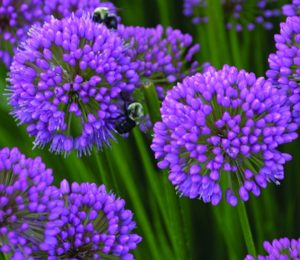
Allium ‘Millenium’ with masses of rose-purple blooms.
The Perennial Plant Association (PPA) selected its 2018 Perennial Plant of the Year: Allium ‘Millenium’ (yes, that’s Millenium with just one n). This announcement continues to show the focus on pollinator habitat these days — Allium ‘Millenium’ is appropriately referred to as a butterfly and bee magnet!
‘Millenium’ is a hybrid Allium selected for late flowering. It has masses of rose-purple blooms; a uniform habit; and neat, shiny, green foliage that remains attractive long after blooms have faded. It is also known for its resistance to drought.
The upright foliage clump of grass-like, glossy, deep-green leaves reaches 10-15 inches tall in spring. In midsummer, two or three flower stalks rise above the foliage, and each produces two or three showy globes of rose-purple florets that last as long as four weeks. They dry to a light tan, often holding a blush of their former rose-purple color.
‘Millenium’ is just about the perfect low-maintenance perennial for full sun. Once established, about the only maintenance it needs is cutting back foliage in late fall after the plants fade. This plant is hardy to USDA zones 4-9 (possibly zone 3), which makes it a great choice throughout the Midwest. No serious pest problems have been reported, though leaf spot may occur in overcrowded growing conditions with decreased air circulation. Deer and rabbits appear to avoid browsing.
Gardeners sometimes avoid planting Alliums because of their unwanted reseeding behavior. Fortunately, ‘Millenium’ produces 50 percent fewer seeds, which raises less concern for unwanted self-seeding.
‘Millenium’ has a clump habit with a fibrous root system, which makes it easy to propagate by division in either spring or fall.
The Perennial Plant Association selects a different perennial plant each year to promote throughout the nursery and gardening industry. PPA members nominate plants based on several criteria, including low maintenance needs, adaptability to a wide range of climates, pest and disease resistance, wide availability, multiple seasons of interest, and ease of propagation. A selection committee then narrows the field to three or four choices from which the members cast their votes.
For more information about the Perennial of the Year program, see www.perennialplant.org.
Previous PPA Perennial Plant of the Year winners:
- 2017 Asclepias tuberosa (butterfly milkweed)
- 2016 Anemone × hybrida ‘Honorine Jobert’ (windflower)
- 2015 Geranium ‘Biokova’ (dwarf cranesbill, hardy geranium)
- 2014 Panicum virgatum ‘Northwind’ (tall switch grass)
- 2013 Polygonatum odoratum var. variegatum (Solomon’s seal)
- 2012 Brunnera macrophylla ‘Jack Frost’ (Siberian bugloss)
- 2011 Amsonia hubrichtii (blue star)
- 2010 Baptisia australis (blue false indigo)
- 2009 Hakonechloa macra ‘Aureola’ (Japanese forest grass)
- 2008 Geranium ‘Rozanne’ (cranesbill, hardy geranium)
- 2007 Nepeta racemosa ‘Walker’s Low’ (catmint)
- 2006 Dianthus ‘Feuerhexe’ (aka ‘Firewitch’) (cheddar pink)
- 2005 Helleborus x hybridus (hellebore, Lenten rose)
- 2004 Athyrium niponicum var. pictum (Japanese painted fern)
- 2003 Leucanthemum × superbum ‘Becky’ (shasta daisy)
- 2002 Phlox paniculata ‘David’ (garden phlox)
- 2001 Calamagrostis × acutiflora ‘Karl Foerster’ (feather reed grass)
- 2000 Scabiosa ‘Butterfly Blue’ (pincushion flower)
- 1999 Rudbeckia fulgida var. sullivantii ‘Goldsturm’ (black-eyed Susan)
- 1998 Echinacea purpurea ‘Magnus’ (purple coneflower)
- 1997 Salvia × sylvestris ‘Mainacht’ (aka ‘May Night’) (wood sage)
- 1996 Penstemon digitalis ‘Husker Red’ (beardtongue)
- 1995 Perovskia atriplicifolia (Russian sage)
- 1994 Astilbe ‘Sprite’ (dwarf astilbe)
- 1993 Veronica ‘Sunny Border Blue’ (speedwell)
- 1992 Coreopsis verticillata ‘Moonbeam’ (threadleaf coreopsis)
- 1991 Heuchera micrantha var. diversifolia ‘Palace Purple’ (coral bells)
- 1990 Phlox stolonifera (creeping phlox)
Photo Credit: Perennial Plant Association